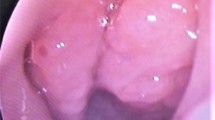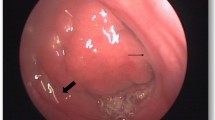Abstract
Diseases of adenoids are commonly observed in children. It indirectly leads to pathology in the middle ear cleft. It has been demonstrated both by radiological techniques and middle ear pressure studies that adenoids can and do obstruct the Eustachian Tube. The Adenoid—Nasopharyngeal Ratio (ANR), can offer a simple arithmetic measure of nasopharyngeal obstruction. Coupled with tympanometry, it also predicts the degree to which the middle ear is affected. Multicentric study done at two centres in India. 230 patients were studied. Children were in the age group of 5–14 years. The nasopharyngeal and adenoid dimensions were measured separately using the Fujioka method. The adenoid-nasopharyngeal ratio was derived by the arithmetic method. All patients were also subjected to tympanometry. ANR decreased from 0.728 to 0.663 with an increase in age from 5 to 12 years. ANR between 0.701–0.800 had maximum number of Type B (140) and Type C (71) Tympanogram whereas between 0.801 and 0.900, all Tympanogram were found to be of Type B or Type C with none belonging to Type A. Using ANR and Tympanometry, the effects of the adenoids on the middle ear can be quantified indirectly. Both these modalities are easily available, economical, safe and can be performed at the Out Patient Level. This aids in timely and appropriate management thus preventing discomforting symptoms caused by the adenoids locally and also the morbidity caused to the middle ear in the long term.

Copyright 1979 by the American Roentgen Ray Society.)

Copyright 1979 by the American Roentgen Ray Society.)




Similar content being viewed by others
References
Cowen DL, Hibbert J (1997) Tonsils and adenoids. In: Kerr AG (ed) Scott-Brown’s otolaryngology, 6th edn, UK, Butterworth Heinemann Ltd, pp 6/18/4–5.
Brodsky L (1997) Adenotonsillar diseases in children. In: Robin T, Cotton MD (eds) Practical pediatric otolaryngology. M.D.,New York, Lippin Cott-Raven
Bluestone C (1975) Obstructive adenoids in relation to otitis media. Annals of Otology Rhinology Laryngology 84(19_suppl):44–48
Shaw AR (1997) Otitis media with effusion. In: Kerr AG (ed) Scott-Brown’s otolaryngology, 6 edn, UK, Butterworth Heinemann Ltd, pp 6/7/1–17.
Phelps PD (1997) Radiology in pediatric otolaryngology. In: Kerr AG (ed) Scott Brown’s otolaryngology, 6 edn, UK, Butterworth Heinemann Ltd. pp 6/2/1–9.
Fujioka M, Young L, Girdany B (1979) Radiographic evaluation of adenoidal size in children: adenoidal-nasopharyngeal ratio. Am J Roentgenol 133(3):401–404
Larsen PL, Tos M, Stangerup SE (1997) Progression of drum pathology following secretory otitis media. In: Lim DJ (ed) Recent advances in otitis media, vol 1988. Hamilton, B.C. Decker, pp 34–38
Onusko E (2004) Tympanometry. Am Fam Phys 70:1713–1720
Chien C, Chen A, Hwang C, Su C (2005) The clinical significance of adenoid–choanae area ratio in children with adenoid hypertrophy. Int J Pediatr Otorhinolaryngol 69(2):235–239
Sente M, Sente R (2000) Evaluation of the level of hearing loss based on the results of tympanometry in children under five years of age with Eustachian tube dysfunction. Med Pregl 53:559–563
Nwosu C, Uju Ibekwe M, Obukowho Onotai L (2016) Tympanometric findings among children with adenoid hypertrophy in Port Harcourt, Nigeria. Int J Otolaryngol. https://doi.org/10.1155/2016/1276543
Egeli E, Oghan F, Ozturk O, Harputluoglu U, Yazici B (2005) Measuring the correlation between adenoidal-nasopharyngeal ratio (AN ratio) and tympanogram in children. Int J Pediatr Otorhinolaryngol 69(2):229–233
Funding
None.
Author information
Authors and Affiliations
Corresponding author
Ethics declarations
Conflict of interest
None.
Ethics Approval
Approval was obtained from the ethics committee of KLE Academy of Higher Education and Research (formerly KLE University). The procedures used in this study adhere to the tenets of the Declaration of Helsinki.
Consent to Participate
Written informed consent was obtained form the parents/ legal guardians of the study participant.
Consent for Publication
The authors affirm that human research participants provided informed consent for publication of the images.
Additional information
Publisher's Note
Springer Nature remains neutral with regard to jurisdictional claims in published maps and institutional affiliations.
Rights and permissions
About this article
Cite this article
Kumar, A., Belaldavar, B.P. & Havaldar, R.R. Correlative Multicentric Analysis of Dimensions of Nasopharynx and Adenoid Size, and its Burden in Otitis Media with Effusion: An Indian Scenario. Indian J Otolaryngol Head Neck Surg 74 (Suppl 1), 153–159 (2022). https://doi.org/10.1007/s12070-020-01938-2
Received:
Accepted:
Published:
Issue Date:
DOI: https://doi.org/10.1007/s12070-020-01938-2




